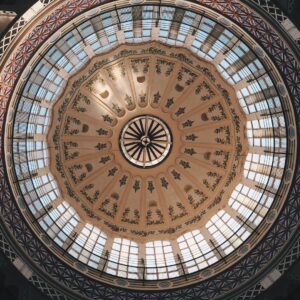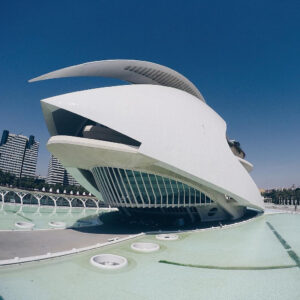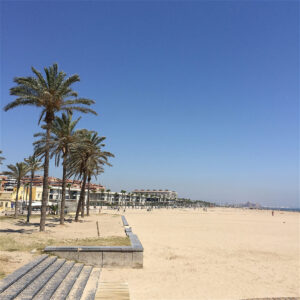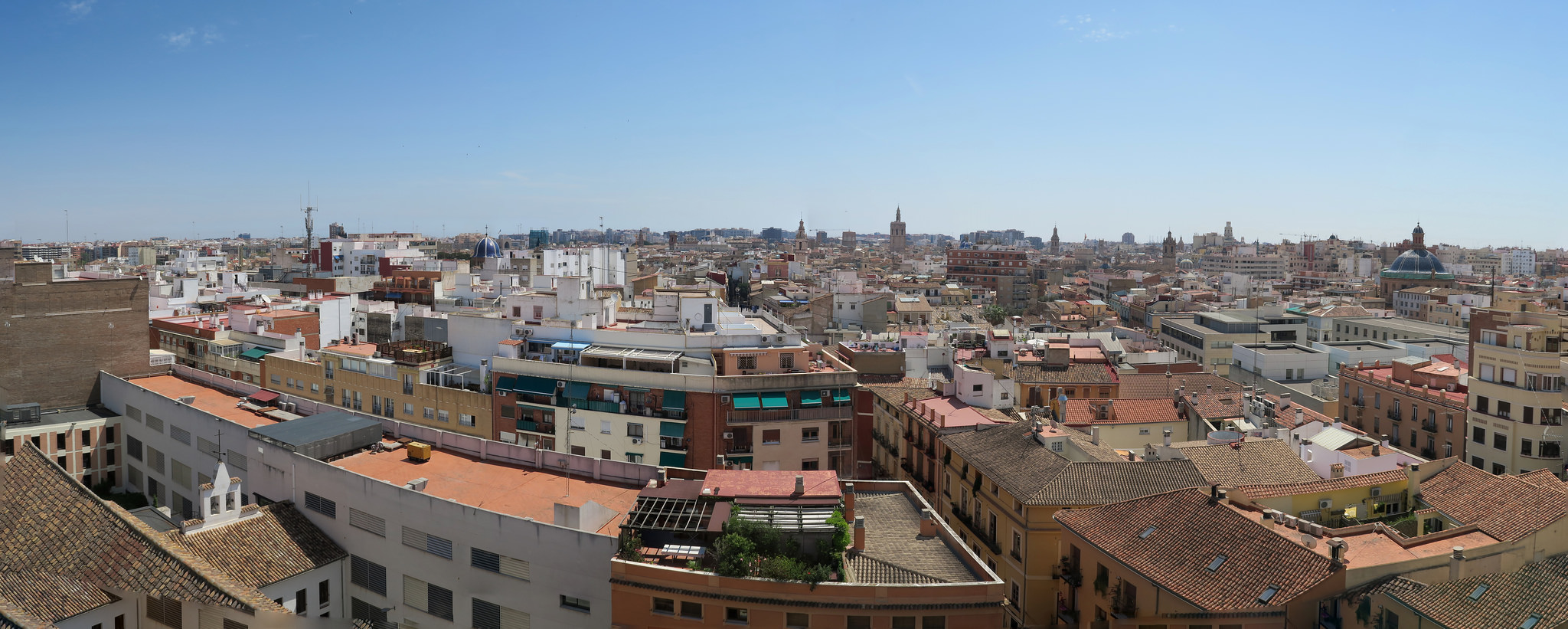Three days Valencia is excellent to recon the city in all its facets! Here we show you how to fill a day in a modern, yet historic Spanish city.
From the airport it is very easy to reach the city center. The metro takes you there in about 20 minutes. We were surprised by the calmness, however we did arrive on a Sunday! The center itself is small and busy but not too crowded.
 Our hotel was located right in the middle of the old town, which was excellent to discover the old center on foot (ear plugs are your rescue for the noise during the night). Sunday afternoon we spent walking through the narrow streets of the burrow El Carmen. If you’re a fan of street art, this is the place to be (see the flickr album)!
Our hotel was located right in the middle of the old town, which was excellent to discover the old center on foot (ear plugs are your rescue for the noise during the night). Sunday afternoon we spent walking through the narrow streets of the burrow El Carmen. If you’re a fan of street art, this is the place to be (see the flickr album)!
Day two was reserved for the real touristic thing. The old town (Ciutat Vella) has no more secrets for us. We started the day at the Central Market, which is located in a beautiful building! Watch for the city emblem in the glass parts inside, and be sure to take a walk outside around the Art Nouveau building. If you want anything typical Spanish/Valencian or just some fresh food, you’ll find it here! Right across the street, a World Heritage Listed building can be found: the Silk Exchange (Lonja de la Seda). Nowadays, you can’t find no more silk inside, but lace can be found at the Plaza Redonda. A small arena-like square. Around the fountain some ladies are filling their days making artisan products, which are also sold in the stalls. The Plaza has several ‘exits’. One goes to the Plaza Lope de Vega. Nothing special at first sight. But a reason to actually stop here is the smallest house in Europe. Watch for number 8! From there, we moved on to the first height (litteraly) of our trip: El Miguelete. It is a strange sight: the cathedral (which is famous because the Holy Grail – the real one – is kept here) doesn’t have a tower on top of it. The tower is build next to the cathedral. However, the two are connected to each other with a kind of bridge. The heighest tower in Valencia offers a nice view over the city (€ 2 per person). The heaviest clock – El Miguelete – hangs outside. Be careful, there are no warning signs this clock is actually working!
Since we were visiting high places today, we decided to walk to Torres de Quart. It is one of the three remaining city gates from the medieval wall. Going up you see the El Carmen and Ciutad Vella quarters at your feet. The gate at the border of the old town, Torres de Serranos, is also nice, but less impressive if you went up on Torres de Quart first. It is the biggest though, and historical wise the more important one. Both cost € 2 per person. The oldest gate still standing can be found in the middle of the old center: Portal de Valldigna, built in 1400. Very easy to be overlooked, but very beautiful if you do see it!
Other buildings worth a look are the city hall – Ayuntamiento – free to enter (but closed when we got there) and the post office (Edificio de Correos). The last one has an enormous and beautiful glass-framed ceiling. Both building are on Plaza del Ayuntamiento. The façade of the Palacio del Marqués de Dos Aguas is fascinating. This façade is made out of alabaster (the stone we found in Tuscany). The building itself dates from the 15th Century and is one of the remains of the Moorish history. The train station is perhaps self-evident – or not. Who visits a train station if one doesn’t take a train? Still, it has one of the most beautiful entrances we’ve ever seen! Next to it, you can find the arena where sadly enough bull fightings are still taking place.
The train station is a bit on the border with another nice area in Valencia: Eixample. This is the more modern part of the town. Nice to walk through and see the difference. The Ruzafa area is just a few meters away and totally different, read: multicultural and hip.
Valencia is a very bike-friendly town. Hiring a bike is easy at one of the many shops and a real delight! We drove through the Turia Gardens (Jardines del Turia). The garden was created by diverting the Turia river to the outer skirts of town. So we were actually driving through the old river beds! Very cool, since all the original bridges (including the oldest of the city – the Puente de la Trinidad – 14th Century) are still standing. Something which is probably unique in the world! We drove all the way to a completely new part of town: Ciutad de las Artes y las Ciencias (CAC) – the  City of Art and Sciences. I say new, because the last building was completed in 2009. There are seven gigantic and modern structures created at the end of the Turia Gardens. Very impressive! The first building is the Palau de la Musica, but the architectural highlights are to be found a bit further. You can easily spend a complete day at this place, even when you don’t go inside the Museum of Science (Museo de la Sciencias Principe Felipe), or the opera building (Palau de les Arts Reina Sofia). The most expensive and biggest complex is the Oceanografic, a huge aquarium and oceanic related place. We took the most out of our self-transport, and went to see the new harbour too. The Marina Real Juan Carlos I was build in the beginning of the 2000’s, with the goal to host the America’s Cup (prestigious sailing competition). It even welcomed the Formula One circus. It left the city of Valencia with huge debts (the City of Arts was build around the same time, and was a bit more expensive than initially calculated). The result however is a modern yacht harbour. Our day ended by driving back to the city through the Turia Garden.
City of Art and Sciences. I say new, because the last building was completed in 2009. There are seven gigantic and modern structures created at the end of the Turia Gardens. Very impressive! The first building is the Palau de la Musica, but the architectural highlights are to be found a bit further. You can easily spend a complete day at this place, even when you don’t go inside the Museum of Science (Museo de la Sciencias Principe Felipe), or the opera building (Palau de les Arts Reina Sofia). The most expensive and biggest complex is the Oceanografic, a huge aquarium and oceanic related place. We took the most out of our self-transport, and went to see the new harbour too. The Marina Real Juan Carlos I was build in the beginning of the 2000’s, with the goal to host the America’s Cup (prestigious sailing competition). It even welcomed the Formula One circus. It left the city of Valencia with huge debts (the City of Arts was build around the same time, and was a bit more expensive than initially calculated). The result however is a modern yacht harbour. Our day ended by driving back to the city through the Turia Garden.
 If you have a day left, there are more things to do around Valencia. We went to the beach. A typical Costa Brava beach, but the further you walk, the more authentic the houses become in the Cabanyal area. We just didn’t want to sit on the bus for an hour to go to the Albufera Nature Park. Nature in the city center is a bit limited. The biggest park is of course the Turia Garden, but smaller parks like the Jardines del Real y Viveros are nice as well. The botanical garden (Jardin Botanico), close to the Torres de Serranos, is refreshing on a hot day, but be careful for mosquitoes! Entrance fee is € 2,5.
If you have a day left, there are more things to do around Valencia. We went to the beach. A typical Costa Brava beach, but the further you walk, the more authentic the houses become in the Cabanyal area. We just didn’t want to sit on the bus for an hour to go to the Albufera Nature Park. Nature in the city center is a bit limited. The biggest park is of course the Turia Garden, but smaller parks like the Jardines del Real y Viveros are nice as well. The botanical garden (Jardin Botanico), close to the Torres de Serranos, is refreshing on a hot day, but be careful for mosquitoes! Entrance fee is € 2,5.
have a look at the full album on ![]() and the streetart that you can find in Valencia in this album
and the streetart that you can find in Valencia in this album
one picture got selected and is featured on the vsco website or see the full gallery : 
